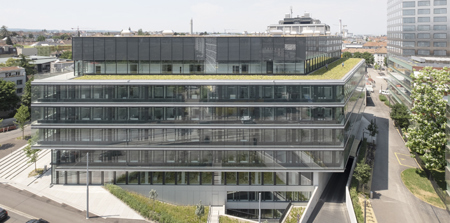

BSS - Laboratory & Research Building ETH Zurich
Nickl & Partner
Though it may not appear so at first glance, it is a state-of-the-art research and laboratory facility. The design incorporates an ideal and flexible room concept evolving around a central laboratory core. This provides clearly defined work areas for the department‘s individual units while allowing interconnectivity across floors through spiral staircases serving as shortcuts. Numerous communication areas and visual connections to both the interior and exterior enhance the user experience. The result is a multifaceted building that offers a high quality of stay, embodying a corporate architecture that subtly reflects the excellence of ETH Zurich and it‘s surroundings. This thoughtful design ensures that the BSS not only serves its functional purpose but also fosters an environment conducive to collaboration and innovation. Unlike conventional layouts that conceal laboratories, evaluation zones, and seminar rooms behind corridors, the BSS arranges these diverse spaces along the atrium, making them visible and accessible. Student learning areas animate the ground floor, while research group laboratories occupy the upper floors. At the very top, the Science Lounge provides seminar and event spaces enhanced by a roof terrace and a panoramic view of the city. The atrium is spanned by a 20m × 35m glass dome with a grid shell appearance. This mesh structure, without supports, is the first of its kind in Switzerland. Its main elements intersect, forming triangular mesh elements at various angles. Systematic node construction optimized the manufacturing and installation process, allowing the atrium roof to be realized without a secondary structure for glazing. The uniqueness of the patented node lies in using an unprocessed steel cylinder as the node center, with adjoining steel profiles laser-cut and numbered for easy assignment and welding. Planned in 3D, the steel parts were directly processed on the tube laser. Altogether, the roof consists of 239 glass pieces, none of which have the same dimensions. A transparent facade highlights the representative areas of the building with large-format glazing. In order to utilize the advantages of its central location without being affected by its disadvantage an open structure allows for intensive interaction with the immediate surroundings, while the construction ensures a quiet, comfortable, and safe work environment. With the commissioning of the BSS, up to 600 employees and students will benefit from an environment that meets the highest technical standards for high-quality research work. The ground, first, and fifth floors have floor-to-ceiling post-and-beam facades, with public areas visible from outside. Triple sun-heat protection glazing and a double-layer facade with wood/aluminum window elements enhance thermal efficiency.